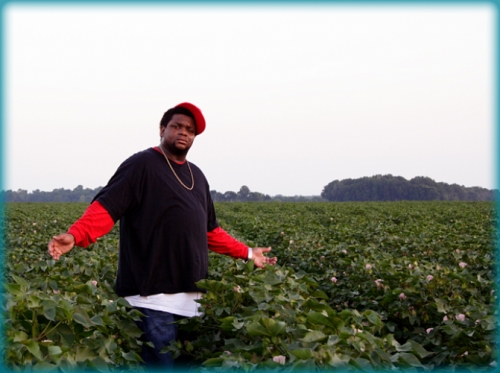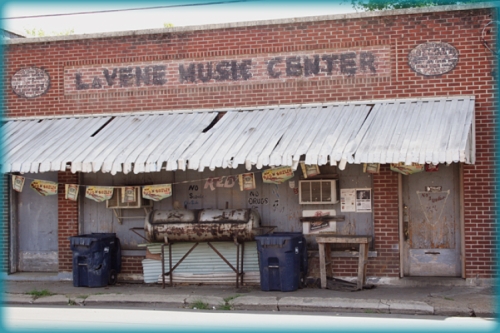Ali Neff’s van broke down at the crossroads where, legend has it, Robert Johnson sold his soul to the devil for a few guitar licks. Right down the street from where Muddy Waters, John Lee Hooker, and Charley Patton used to dazzle their fans. Those bluesmen and their juke joints are hard to find now. Neff wanted to see what was left.
She was in the mood for an adventure. And after reading books such as Amiri Baraka’s Blues People and William Ferris’s Blues from the Delta, she went to Clarksdale, Mississippi — the heart of Delta blues — not just to visit, but to live there and maybe even write a book. But on the cracked streets she heard another kind of music coming from cars and rickety porches. It was hip-hop. Beats and raps made up on the spot — reminiscent, she thought, of old bluesmen trading guitar licks.
“Hip-hop in the Delta,” she thought to herself. “Makes sense.”
Neff had been a music writer and DJ in San Francisco before trekking cross-country in a van that broke down thirteen times. Once in Clarksdale, she rented a dumpy shack outside of town, worked odd jobs, and searched for the blues. But it took time to find what she was looking for.
“The color line in the Mississippi Delta has always been especially thick,” she says. “And the entire community has traditionally been closed to outsiders.”
Finally, at Red’s — one of the only juke joints that’s not overly touristy — Neff met blues musicians and singers, one of which she complimented between sets.
The female singer replied, “You think that was good? You should hear me tomorrow at church.”
Neff showed up at that black church. Friendships deepened, and she was finally invited to a fish fry at a secluded, out-of-town blues bar where she was told Clarksdale’s de facto king of hip-hop was scheduled to perform.
Once there, Neff realized that there was no official hip-hop show. Her new friends merely brought Jerome Williams (a.k.a. Top Notch the Villain) to do his thing outside the club between blues sets.
“So we went outside,” she says. “Palmetto bugs hitting me in the head. Really hot. All these blues guys gathering around, and then this young guy starts rapping. It was amazing.”
His raps were all off the cuff. Lyrics referred to people around him. It all rhymed. It was all in tune and in time. And the rhythms were true.
“The blues guys were freaking out,” Neff says. “They really got it.” What they got was freestyle hip-hop — an art form that shares the same roots, lyrical structures, and soulful realism as the blues.
Neff was sold. She had gone to Clarksdale to research the blues, but Williams inspired her to study Delta hip-hop instead.
While commercial rappers usually write their rhymes before hitting the studio, Delta hip-hop still puts a premium on improvisation, or freestyling. The best rappers have the quickest wits.
Williams, though, says the best rap comes from someplace spiritual.
Life and energy just start flowing,” Williams says in a documentary called Let the World Listen Right, which he and Neff made. “It comes up through my feet and ankles and legs and hips and belly, to my heart and mind until it just gets to the point where I can’t hold it in my body no more, and it just comes out like a big old blur and it’s like beautiful music.”
Neff says that William Ferris, now her mentor at UNC, documented improvisatory blues in the late 1960s, when bluesmen had to conjure lyrics on the spot — they often played to people at house parties, just as Delta rappers do today. Bluesmen would occasionally re-use a favorite line from their other songs — same as hip-hop artists, who also borrow from popular songs, proverbs, and even local lingo, such as calling Clarksdale Clarks Vegas. Such borrowing helps rappers bridge thoughts in midstream, like a poet’s stream of consciousness. It also helps artists compete.
Ferris documented competition forty years ago when Joe Cooper’s ditty trumped James “Son” Thomas’s before a raucous crowd that served as judge. Neff says that such skills developed from games such as the dozens, in which kids use rhymes to insult each other’s mothers. Most rappers don’t like to admit that they played the dozens as kids, she says, but the game did train them to form rhymed couplets — an ability that helps artists perform without a script.
But for Williams, the strongest link between hip-hop and the blues is Clarksdale itself. Boarded-up buildings line the main street. Sky-high unemployment looms over town, and segregation isn’t some old forgotten word. There’s Clarksdale’s white section and then — across the tracks — the black part of town called the New World District.
Williams says that hip-hop is just about what artists see, and what he sees in his neighborhood is economic depression. “We’re actually saying that we’re tired of this,” he says.
Williams, who was a good student in school and later joined the Army, could’ve stayed clear of Clarksdale. But he came back to be with family and friends, some of whom he joined together in a music group called Da Fam.
“People really look up to him,” Neff says. “He grew up in a house with eighteen people. He ate once a day, getting so dizzy that his head would ache and he’d just go to bed early.”
Today, he’s twenty-seven and reads heart monitors at the local hospital as a telemetry technician. And although he’s respected for that, Neff found that his influence runs deeper.
Williams’ cousin Taurus Metcalf says, “I can remember him rapping as a kid, ‘keep your head up, keep pushing; keep your head up, keep pushing.’ We were in second grade. Now I have a wife and kids and I can still hear that — keep your head up, keep pushing. It keeps my blood flowing.”
At one point during the documentary, Williams sits on a street corner with eleven-year-old Kevon Jurden. The two rap back and forth, a rhythmic conversation. Williams smiles, intones some advice, and then listens to Jurden do his thing — a soul cry, as Williams calls it.
The kid’s gifted. He’s got hope like Williams. And he says things you wish no eleven-year-old had to say.
“If I make it, my rap ain’t gonna be about drugs and killing,” Jurden says. “My raps are gonna be about God and about what people need to be doing and stop doing.”
Ali Colleen Neff, a graduate student in the folklore curriculum in the College of Arts and Sciences, is writing a book about Delta hip-hop. Brian Graves, a communications studies graduate student, was the documentary’s third co-director. They received funding from the Center for the Study of the American South. The documentary is online at www.folkstreams.net/listenright. On January 25, 2007, a free viewing of African American Culture in the South: Short Films by Ali Colleen Neff and Brian Graves will be held at 7 p.m. in room 203, Bingham Hall.




